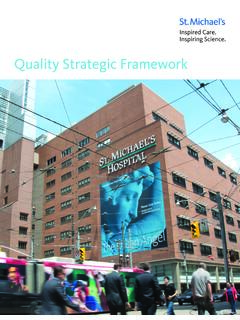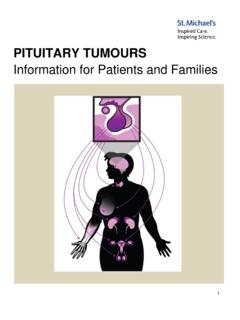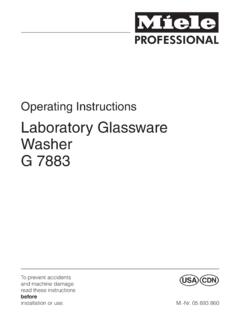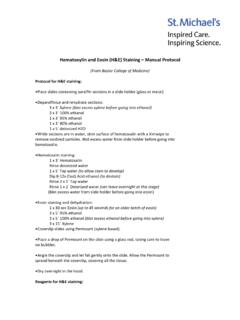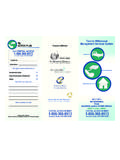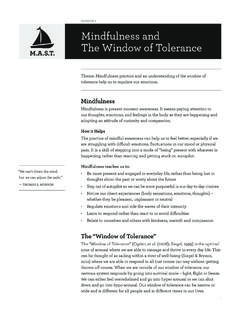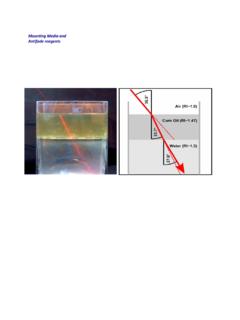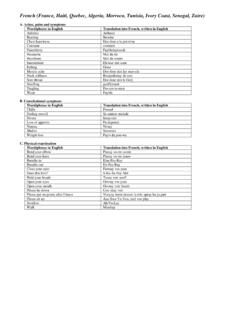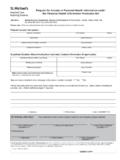Transcription of Dietary pulses, satiety, and food intake: A systematic ...
1 Dietary Pulses, satiety , and food intake : A SystematicReview and Meta-analysis of Acute Feeding TrialsSiying S. Li1,2, Cyril Kendall1,2,3, Russell J. de Souza2,4, Viranda H. Jayalath1,2, Adrian I. Cozma1,2, Vanessa Ha1,2,Arash Mirrahimi1,2,5, Laura Chiavaroli1,2, Livia Augustin2, Sonia Blanco Mejia1,2, Lawrence A. Leiter1,2,6,7,8,Joseph Beyene4,9,10, David Jenkins1,2,6,7,8and John L. Sievenpiper2,7,111 Department of Nutritional Sciences, Faculty of Medicine, University of Toronto, Toronto, ON, Canada. Correspondence: Cyril WC 3D Knowledge Synthesis and Clinical Trials Unit, Clinical Nutrition and Risk Factor Modification Centre, s Hospital, Toronto, ON, Canada3 College of Pharmacy and Nutrition, University of Saskatchewan, Saskatoon, SK, Canada4 Department ofClinical Epidemiology and Biostatistics, Faculty of Health Sciences, McMaster University, Hamilton, ON, Canada5 School of Medicine, Faculty of HealthSciences, Queen s University, Kingston, ON, Canada6 Division of Endocrinology and Metabolism, St.
2 Michael s Hospital, Toronto, ON, Canada7Li KaShing Knowledge Institute, St. Michael s Hospital, Toronto, ON, Canada8 Department of Medicine, Faculty of Medicine, University of Toronto, Toronto,ON, Canada9 The Dalla Lana School of Public Health, Faculty of Medicine, University of Toronto, Toronto, ON, Canada10 Population Health Sciences,Research Institute Hospital for Sick Children, Toronto, ON, Canada11 Department of Pathology and Molecular Medicine, Faculty of Health Sciences,McMaster University, Hamilton, ON, CanadaFunding Agencies: This work was funded by a grant from pulse Canada and a Canadian Institutes of Health Research (CIHR) Knowledge Synthesis Grant (Funding ReferenceNumber, 119797). was funded by a CIHR Postdoctoral Fellowship Award and , by a CIHR Canada Graduate Scholarship Master s award. was funded by an OntarioGraduate Scholarship. was funded by a Fredrick Banting and Charles Best Canada Graduate Scholarship and Banting and Best Diabetes Centre (BBDC)-Novo NordiskStudentship.
3 DJAJ was funded by the Government of Canada through the Canada Research Chair Endowment. None of the sponsors had a role in any aspect of thetrial,includingstudy design and conduct; collection, management, analysis, and interpretation of data; and preparation, review, or approval of the : has received research support from the Advanced Foods and Material Network, Agrifoods and Agriculture Canada, the Almond Board of california , the AmericanPistachio Growers, Barilla, the california strawberry commission , the Calorie Control Council, Canadian Institutes of Health Research (CIHR), the Canola Council of Canada, the Coca-ColaCompany (investigator initiated, unrestricted grant), Hain Celestial, the International Tree Nut Council Nutrition Research and Education Foundation, Kellogg, Kraft, Loblaw Companies Ltd., Orafti, pulse Canada, Saskatchewan pulse Growers, Solae and Unilever. He has received travel funding, consultant fees orhonoraria from Abbott Laboratories, the Almond Board of california , theAmerican Peanut Council, the American Pistachio Growers, Barilla, Bayer, the Canola Council of Canada, the Coca-Cola Company, Danone, General Mills, the International Tree Nut CouncilNutrition Research and Education Foundation, Kellogg, Loblaw Companies Ltd.
4 , the Nutrition Foundation of Italy (NFI), Oldways Preservation Trust, Orafti, Paramount Farms, the Peanut Institute,PepsiCo, pulse Canada, Sabra Dipping Co., Saskatchewan pulse Growers, Solae, Sun-Maid, Tate and Lyle, and Unilever. He is on the Dietary Guidelines Committee for the Diabetes NutritionStudy Group (DNSG) of the European Association for the Study of Diabetes (EASD) has served on the scientific advisory board for the Almond Board of california , the International Tree NutCouncil, Oldways Preservation Trust, Paramount Farms and pulse Canada. is funded by a CIHR Postdoctoral Fellowship Award and has received research support from the CIHR, theCalorie Control Council, the Canadian Foundation for Dietetic Research and the Coca-Cola Company (investigator initiated, unrestricted grant). He has served as an external resource person toWHO s Nutrition Guidelines Advisory Group and received travel support fromWHO to attend group meetings. He is the lead author of 2 systematic reviewsand meta-analyses commissionedby WHO of the relation of saturated fatty acids and trans fatty acids with health outcomes.
5 Has received a Province of Ontario Graduate Scholarship and CIHR-Fredrick Banting andCharles Best Canada Graduate Scholarship and Banting and Best Diabetes Centre (BBDC)-Novo Nordisk Studentship. has received a Province of Ontario Graduate Scholarship andresearch support from the CIHR and payment from the World Health Organization (WHO) for work on a systematic review and meta-analysis commissioned bythe WHO of the relation ofsaturated fatty acids with health outcomes. and also received separate travel awards to attend the Journey Through Science Day hosted by PepsiCo and the New York Academyof Sciences (NYAS). , and have received research support from the CIHR. is also a casual research coordinator at Glycemic Index Testing Laboratories. has receivedresearch grants from Saskatchewan pulse Growers, the Agricultural Bioproducts Innovation Program through the pulse Research Network, the AdvancedFoodsandMaterialNetwork,LoblawCo mpanies Ltd., Unilever, Barilla, the Almond Board of california , the Coca-Cola Company (investigator initiated, unrestricted grant), Solae, Haine Celestial, the Sanitarium Company, Orafti, theInternational Tree Nut Council Nutrition Research and Education Foundation, the Peanut Institute, the Canola and Flax Councils of Canada, the Calorie Control Council, the CIHR, the CanadaFoundation for Innovation and the Ontario Research Fund.
6 He has been on the speaker s panel for the Almond Board of california . He has served on the scientific advisory board of theSanitarium Company, Agri-Culture and Agri- food Canada, the Canadian Agriculture Policy Institute, the california strawberry commission , LoblawCompanies Ltd., Herbalife International,Nutritional Fundamentals for Health, Pacific Health Laboratories, Metagenics, Bayer Consumer Care, Orafti, Dean Foods, Kellogg s, Quaker Oats, Procter & Gamble, the Coca- Cola Company,the Griffin Hospital (for the development of the NuVal scoring system), Abbott Laboratories, pulse Canada, Saskatchewan pulse Growers and the Canola Council of Canada. He has receivedtravel support and or honoraria for scientific advice from the Sanitarium Company, Orafti, the Almond Board of california , the American Peanut Council, the International Tree Nut CouncilNutrition Research and Education Foundation, the Peanut Institute, Herbalife International, Pacific Health Laboratories, Nutritional Fundamental for Health, Barilla, Metagenics, Bayer ConsumerCare, Unilever Canada and Netherlands, Solae, Kellogg, Quaker Oats, Procter & Gamble, the Coca-Cola Company, the Griffin Hospital, Abbott Laboratories, the Canola Council of Canada,Dean Foods, the california strawberry commission ,Haine Celestial, PepsiCo, the Alpro Foundation,Pioneer Hi- Bred International, DuPont Nutrition and Health, Spherix Consulting andWhiteWave Foods, the Advanced Foods and Material Network, the Canola and Flax Councils of Canada, the Nutritional Fundamentals for Health, Agri-Culture and Agri- food Canada, theCanadian Agri- food Policy Institute, pulse Canada.
7 The Saskatchewan PulseGrowers, the Soy Foods Association of North America, NFI, Nutra- Source Diagnostics, the McDougall Program,the Toronto Knowledge Translation Group (St. Michael s Hospital), the Canadian College of Naturopathic Medicine, The Hospital for Sick Children, the Canadian Nutrition Society (CNS), theAmerican Society of Nutrition (ASN), Arizona State University, Paolo Sorbini Foundation and the Institute of Nutrition, Metabolism and Diabetes. He received an honorarium from the USDepartment of Agriculture to present the 2013 Atwater Memorial Lecture. He received the 2013 Award for Excellence in Research from the International Nut and Dried Fruit Council. Hereceived funding and travel support from the Canadian Society of Endocrinology and Metabolism to produce mini cases for the Canadian Diabetes Association. His wife is a director and partnerof Glycemic Index Laboratories, and his sister received funding through a grant from the St. Michael s Hospital Foundation to develop a cookbook for support from CIHR, the Calorie Control Council and the Coca-Cola Company (investigator initiated, unrestricted grant).
8 Has received research support from the Canadian Institutesof health Research (CIHR), Calorie Control Council, The Coca-Cola Company (investigator initiated, unrestricted grant), pulse Canada, and The International Tree Nut Council Nutrition Research &Education Foundation. He has received travel funding, speaker fees, and/or honoraria from the American Heart Association (AHA), American College of Physicians (ACP), ASN, National Instituteof Diabetes and Digestive and Kidney Diseases (NIDDK) of the National Institutes of Health (NIH), CDA, CNS, University of South Carolina, Universityof Alabama at Birmingham, OldwaysPreservation Trust, NFI, Calorie Control Council, DNSG of the EASD, International Life Sciences Institute (ILSI) North America, ILSI Brazil, Abbott Laboratories, pulse Canada, Canadian SugarInstitute, Dr. Pepper Snapple Group, The Coca-Cola Company, and Corn Refiners Association. He is ontheClinicalPracticeGuidelinesExpertCom mittee for Nutrition Therapy of both the CDAand EASD, as well as being on the ASN writing panel for a scientific statement on the metabolic and nutritional effects of fructose, sucrose and high fructose corn syrup.
9 He is a member of theInternational Carbohydrate Quality Consortium (ICQC) and Board Member of the DNSG of the EASD. He serves an unpaid scientific advisor for the ILSI North America, food , Nutrition, andSafety Program (FNSP). His wife is an employee of Unilever Canada. , , , , and have no declared conflicts of interestrelated to this Supporting Information may be found in the online version of this :30 January 2014;Accepted:18 April 2014;Published online 00 Month 2014. |VOLUME 00 | NUMBER 00 | MONTH 20141 ReviewCLINICAL TRIALS: BEHAVIOR, PHARMACOTHERAPY, DEVICES, SURGERYO besityObjective:To assess the effect of Dietary pulses (beans, peas, chickpeas, lentils) on acute satiety andsecond meal intake , a systematic review and meta-analysis was :MEDLINE, EMBASE, CINAHL, and the Cochrane Registry (through May 6, 2013) weresearched for acute controlled trials examining the effect of Dietary pulses on postprandial satiety or sec-ond meal intake compared with isocaloric controls.
10 Two independent reviewers extracted data andassessed methodological quality and risk of bias. Data were pooled by generic inverse variance randomeffects models and expressed as ratio of means (RoMs) for satiety and mean differences (MDs) for sec-ond meal food intake , with 95% confidence intervals (95% CIs). Heterogeneity was assessed (Q statistic)and quantified (I2statistic). Protocol registration: identifier, :Nine trials met the eligibility criteria. Dietary pulses produced a 31% greater satiety incrementalarea under the curve (IAUC) ( , 95% CI: to , ; ;I250%) withoutaffecting second meal intake ( , 95% CI:275-35, ; ;I2563%). Our dataare limited by the small sample sizes, narrow participant characteristics and significant unexplained het-erogeneity among the available :Pooled analyses show that Dietary pulses contribute to acute satiety but not second (2014)00, 00 00. 80% of weight loss interventions are ultimately unsuc-cessful, resulting in regain of weight lost during the trial (1).

